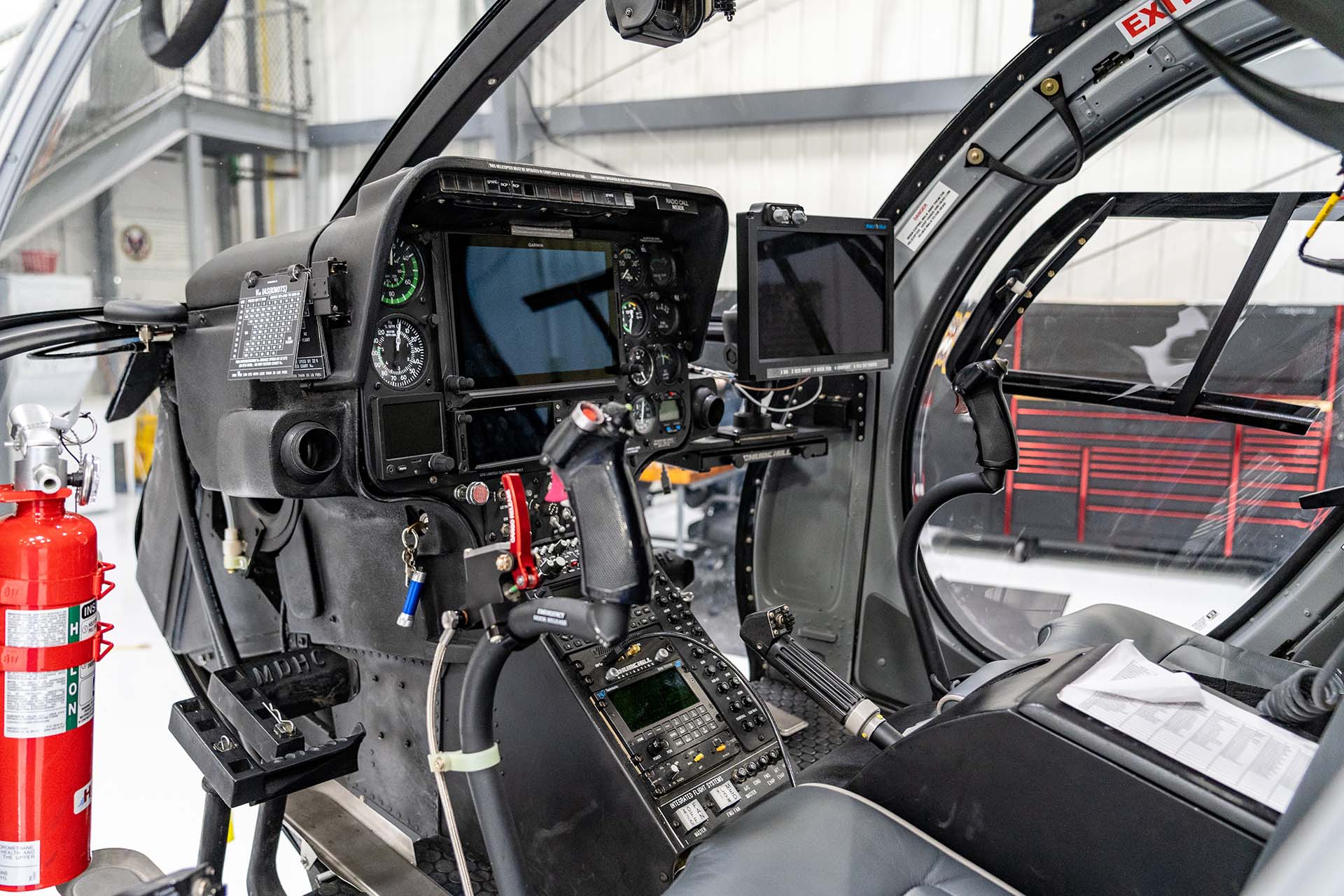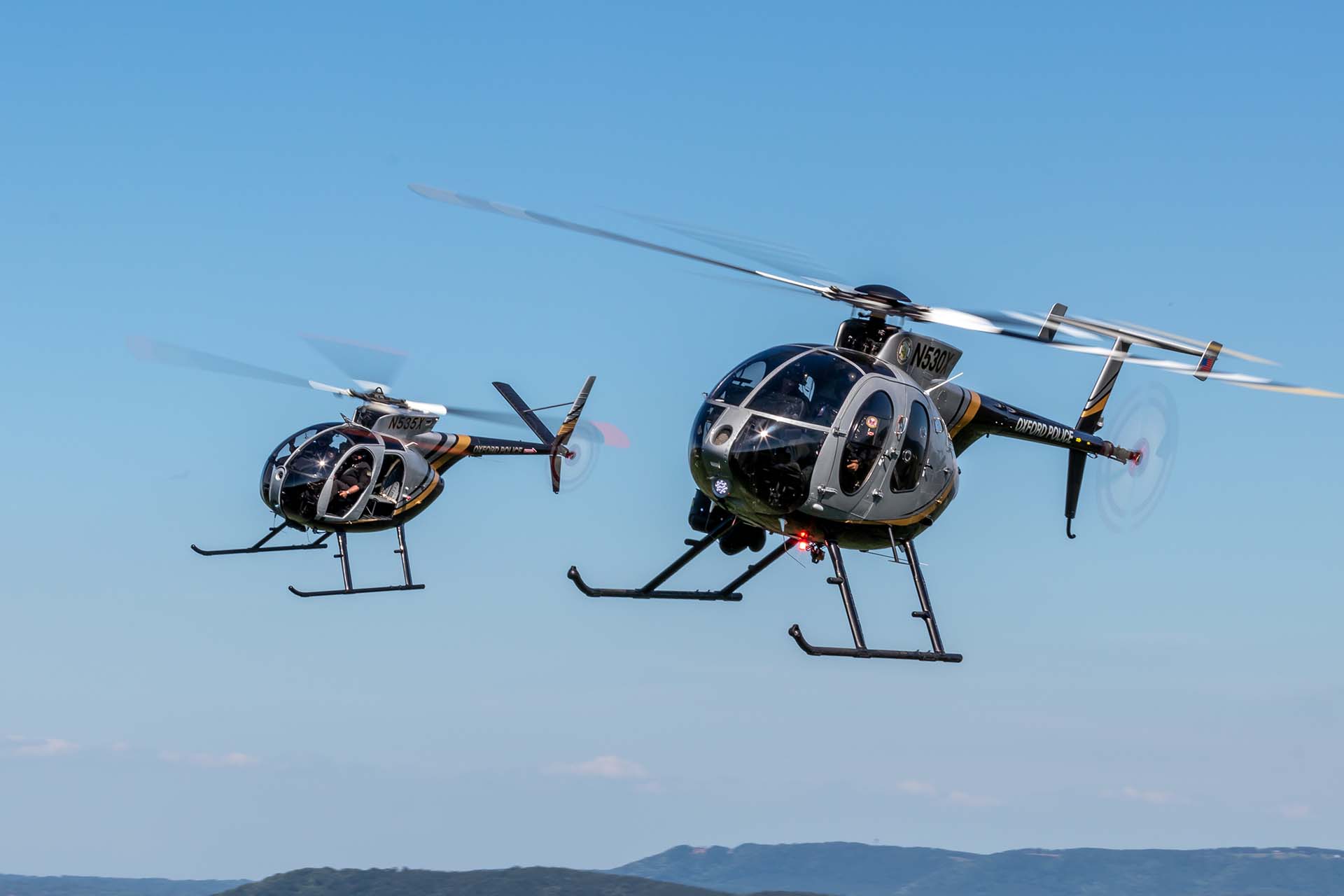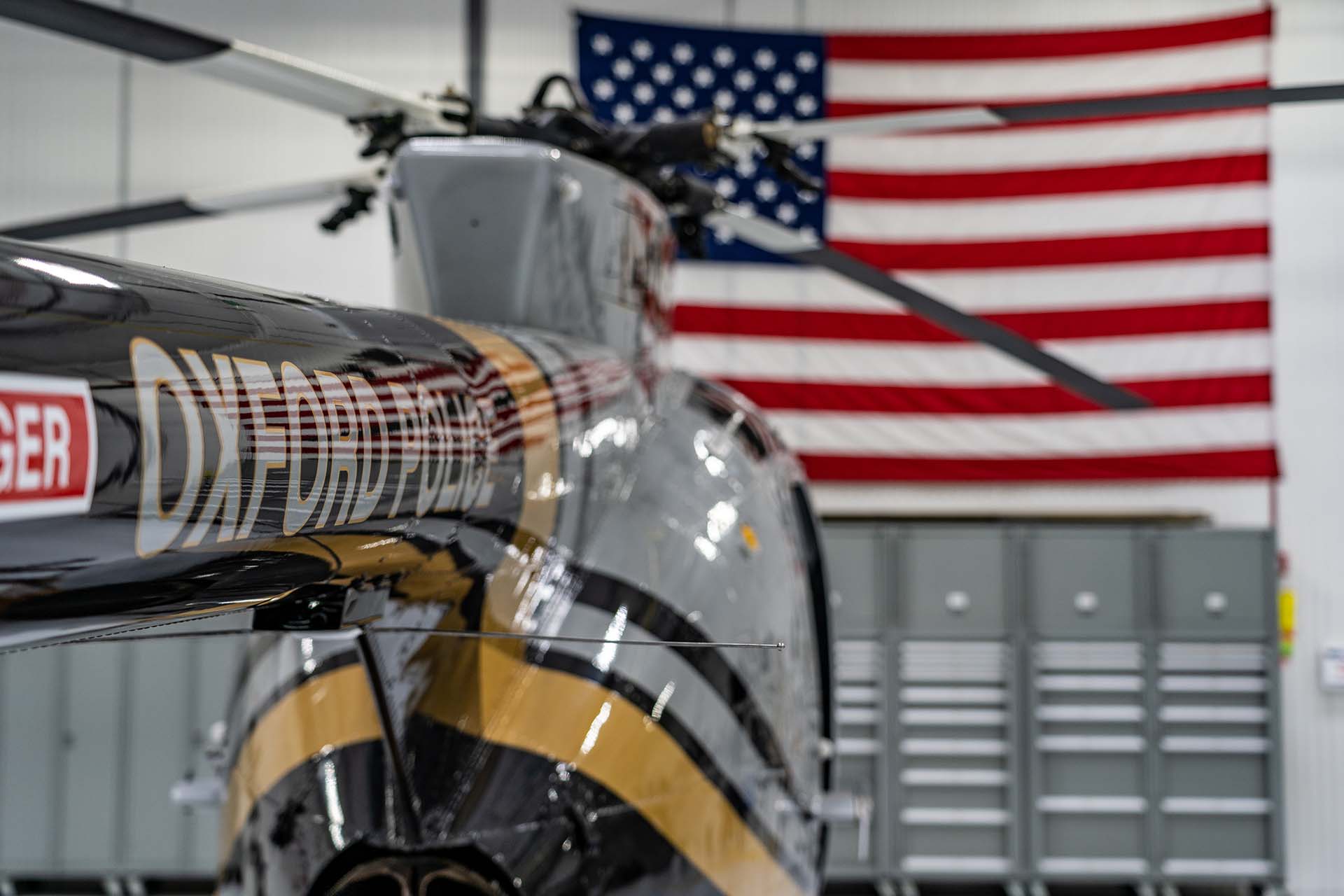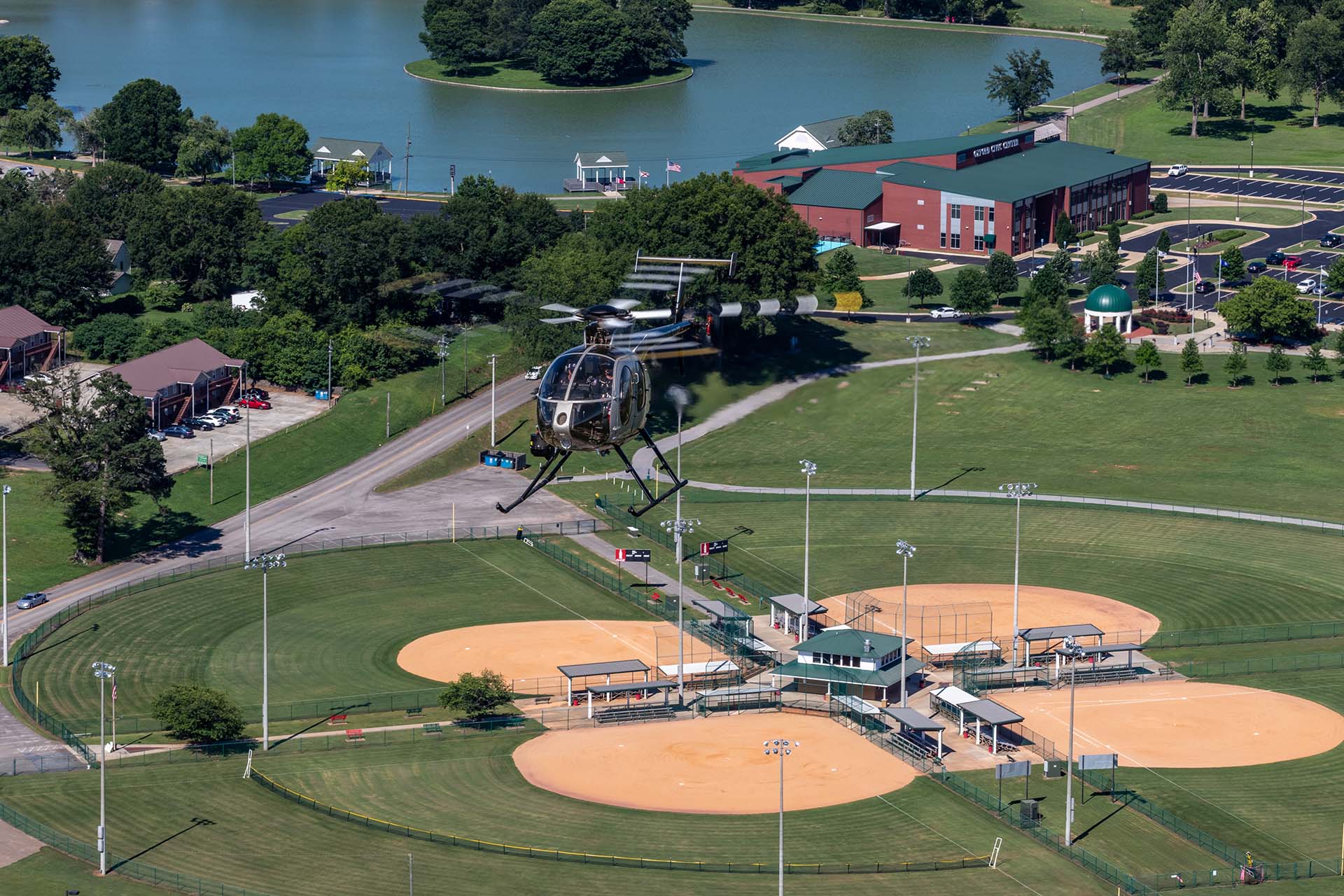Until just over ten years ago, an aviation support unit did not exist even as an idea within east-central Alabama’s Oxford Police Department. Then, in 2011, Lieutenant Jake Durham suggested to Chief of Police Bill Partridge that an OPD aviation unit be established by obtaining a suitable aircraft through the USA’s LESO 1033 program, under which surplus and retired military equipment is available to US law enforcement organizations. Despite initial reluctance from the senior officer, Durham subsequently showed him a rendering of a helicopter in the OPD patrol livery and re-iterated the benefits of aerial law enforcement, successfully persuading the Chief of the program’s merits. A LESO 1033 application was made for an OH58 Kiowa and then everyone waited. And waited.
Finally, in 2015, Durham received notice that an OH6 Cayuse had been made available to the department and that first OPD aircraft duly arrived. It was at this time that an extraordinary stroke of luck fell the department’s way. Someone showed a picture of the ‘new’ Cayuse to Drew Muench, suggesting he contact Durham to offer his assistance. Drew Muench is an extremely highly qualified pilot on both fixed and rotary-wing types, with around 15,000hrs logged in military and civilian aviation. Muench started flying at just twelve years of age, working at an airport fueling and cleaning aircraft, for which he was paid in one flying hour for every ten hours worked. Not only has he been a military CFI, test pilot and examiner pilot, civilian airline pilot and instructor, he is also a fully qualified aircraft A&P mechanic with a Bachelor of Science degree in aeronautical engineering and an Associates in business administration. “I’ve always flown fixed wing on the side so when I left the military I went to the airlines. I still instruct fixed-wing and helicopter on the side, and I have a warbird I do airshows with. Pretty much, if I’m not flying, I’m thinking about flying,” Muench remarked.

Muench contacted Durham and visited Oxford to see the new aircraft. Interested in the program, he started working with the OPD in 2015, sworn in as reserve officer to help with post-inspection test flying and to help set up maintenance on that first OH6. He was subsequently invited to be the program’s Chief pilot – the position he still holds today – and Durham recognizes that Muench’s experience has been instrumental in setting up systems procedures, manuals, SOPs and checklists. Of particular note is that Muench is a volunteer, doing all this part-time for his love of aviation and without financial recompense. Durham himself became an aviation enthusiast after flying with his father, a former Alabama Sheriff, during marijuana eradication operations at the age of sixteen. He has been full-time in law enforcement since 2003, and with the OPD since 2005.
Again via the LESO program, the OPD air unit received a TH67 Creek (military training variant of the Bell 206 JetRanger) in 2016 and this replaced the OH6, which was nearing some expensive major component service-life limits. Although the Creek served for several years, it was not ideal for the task, as Durham explained. “The ‘67 was too heavy and couldn’t carry the extra equipment we wanted, such as a FLIR. Although it’s supposedly a military 206-B3, it’s actually quite a bit heavier. Additionally, we’re operating in confined areas and the ‘67 did not have enough power for max’ performance.”
All the while Durham, whose public safety aviation experience was limited, learned everything he could about all aspects of law enforcement aviation to ensure that the OPD air unit was developed to the highest standards attainable. He was the project manager and designer of the department’s Special Operations Facility constructed in 2017, that now houses the air unit, as well as other special and tactical OPD units. With the shortcomings of the TH67 now apparent, another ex-military OH6 and a 1994 MD530F were acquired in 2020 to replace the Bell. Both new aircraft were completely refurbished and effectively zero-timed, and the OPD took possession of both machines in 2021. Commenting on the rationale behind taking on such an old aircraft as the Cayuse, Durham remarked, “Why would we want to buy a new aircraft if this has already been paid for by the public and is fulfilling its function? This thing was serving our country in Vietnam and now it’s back fifty years later serving again right here. That’s awesome.” Durham commented that the old OH6 is nicer and more fun to fly than the much newer 530F. The older machine is retained primarily for training purposes as the unit carries out pilot and TFO training in-house.

Assisting with training is experienced law enforcement aviation trainer Scott ‘Bob’ Lundsford. Lundsford has trained personnel in many disparate LEA units over many years, and he was impressed with what the OPD unit has put together. “They have a complete SOP, complete training manuals, complete standardization guides and guidelines for within the unit. Their rules of the road, and policies and procedures, everything is already in place for a much bigger unit and that’s impressive,” he stated. “I usually just don’t see that when I visit a unit, and I have canned programs that I have to give them to help them get all that in place.” Durham related that until the 530F arrived in February, the unit had operated without camera or light capability, using map and stabilized binoculars instead. “Our primary mission is patrol – to protect our guys on the ground and do whatever they need us to do,” he stressed. To accomplish that goal, the 530F is equipped with a TrakkaBeam searchlight, Star SAFIRE 380-HDc FLIR (with an 8500 system on the OH6), and Churchill mapping, complete with high-resolution imagery for the local area. A Bambi-bucket is also on order, as the 530 is fitted with a belly-hook and can conduct long line work.
Alongside the Chief pilot, pilots and TFOs, the unit operates with designated ground support staff, who will also drive and man the fuel/maintenance trucks that are currently on order, to give an effective ‘away-from-base’ operational capability. A potential issue with operating such an old airframe as the OH6 is a lack of spare parts. Recognizing this, Durham has assembled a significant inventory of spares for the old machine. “I haven’t spent a lot of money, but we’ve wheeled and dealed, bartered, begged and borrowed, and now we have virtually everything we need for the OH6 except a brand-new engine. And almost all those parts are new, still in their original shipping crates and wrappings from the manufacturer.” Durham stated that the unit also has some TH67 and OH58 spares that he’s happy to release to anyone who needs them, but there’s no way he will release any of the hard-to-obtain Cayuse parts while the unit still operates the old machine.
Oxford is a 32 square mile city, with 22,000 people and a ninety-man police department. Durham considers Bill Partridge to be one of the most progressive Chiefs in the whole south-east and believes the city administrators understand the importance of professional law enforcement. Resources and staffing have meant that until now the unit has only operated every couple of weeks, for four days of the week. “Our key focus moving forward is to get the senior guys trained up and signed off as operational pilots, then integrate and train with the rest of the department, so they know what we can do and how that can change how they think about what they do. At the moment, I feel like the department as a whole just sees us as a toy, yet we’ve already had a remarkable amount of success with the equipment we’ve had available and the limited time we’ve been in the air. We’re currently only flying around 120hrs a year, but that’s about to change,” said Durham, who then outlined his view of the importance of an air unit. “On the wider scale, we offer services to multiple east Alabama jurisdictions consisting of nearly seven-hundred thousand residents at no charge making us a true multi-jurisdictional support agency, with multiple facets. We have the aviation unit, ESU (Emergency Services Unit) unit and our East Metro Area Crime Center. Oxford’s funding and resources are well established and substantial so we don’t just use our equipment for ourselves, because if we can reduce crime in adjacent jurisdictions, it reduces crime in ours. At the local level, we have to be a progressive agency and field an aviation unit, a bomb squad and so forth in order to prolong and enhance the relationship with local agencies and the community.”

Durham does not let his lack of experience get in the way of getting things right. “Our guys are professional enough to understand that if we’re going to do anything of this size, it must be defensible. We complete an FSR (flight summary report) after every flight, recording all flight and mission information. We also report all declinations as it’s equally important to know when and why we are unable to answer a service request. Statistics fuel your unit,” he stated. “We’re still learning to be efficient and effective with the FLIR, light and mapping system but when we get that down pat and are fully operational, our integration into our own police department is going to be the biggest marketing program we’ve ever undertaken. If our own patrol guys and sergeants don’t buy into our program we might as well hang it up, because they won’t be calling us, even though our ultimate goal is to ensure that those guys are taken care of.” Even with the unit’s limited operational availability to date, it has answered a lot of service requests, including searches for missing persons or fugitives at large, and car chases. There has been less flying on marijuana eradication, but the unit is slowly getting into more of it. The current aim is to reach a service level of 12-18 hours a day, and the special op’s facility is being upgraded to include bunks and showers.
Chief Partridge reported that the biggest hurdle he faced was initially trying to sell the concept of the unit to the administrators that approve the required funding. “However, the regional concept means that all 32 agencies we support in and around the region now love it,” he added. Durham believes that it was easier to sell the idea to the city administrators than to the rest of the police department though. “That’s simply because we haven’t been able to provide those guys with the service yet. Once we do provide that service though, it’s not going to be difficult at all.” Muench elaborated, “We’ve been so busy training with the FLIR, the Trakka, the Churchill that we haven’t had much mission time at all, but what we can do for them will mean a revolutionary change in how the ground units think about a lot of what they do, regarding pursuits, containments and the like. It’s been a long, slow road and covid didn’t help, but now we’re on the cusp of really becoming something.”

There is a minimum requirement of two years in the agency for new TFOs, so they have proven experience as boots on the ground and thorough familiarity with their area. Additionally, Durham said that OPD may consider establishing multi-jurisdictional aircrew (not flight crew – pilots or TFOs) in the future, for assisting in their respective areas. The biggest challenge though, is getting sufficient funding and personnel time to meet the high level of training necessary to operate at the desired level. “I wish the community understood our capabilities better, and the time these guys put into the unit. I also wish administrators around the county understood the massive amount of training we constantly do to maintain the highest operational and safety standards,” opined Durham. Muench added, “The hardest thing about keeping this going as it’s being built up has been keeping the guys motivated when they’ve only been able to fly two or three times a month. The biggest roadblock has been personnel and appropriations. I think that in the next 18 to 24 months though, we’ll have two to three mission-trained pilots. It takes time because we’re basically taking them from zero-to-hero by building the unit from within the department.

Sure, Oxford’s air unit is young, with just one primary patrol ship and a training aircraft over fifty years old. Yes, it’s overseen by a lieutenant who began with no public safety aviation experience and has yet to reach full-time staffing and operation. Those facts, however, fail to give any understanding of what this unit has achieved and really is. In a short space of time, Durham has learned more about establishing and running a public safety aviation unit than many professionals with decades of experience. Aided by such legendary industry stalwarts such as Muench, he has established a fledgling unit on groundwork that sets up a safe, effective, accountable and efficient structure, sufficiently well-tailored to allow for major expansion. Watch this space.
 HOME
HOME



